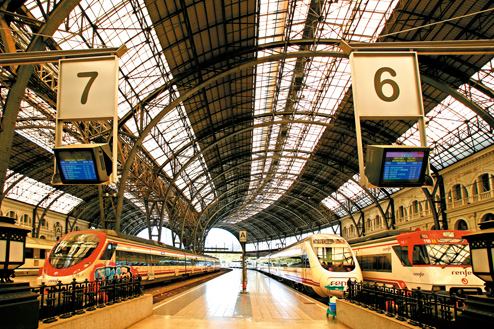Getting Around
Barcelona is an easy city to navigate, with a decent public transport network and plenty of ways to get around. Bicycles, scooters or motorcycles are very popular, and the old town can easily be covered on foot. Kids hop on skateboards, visitors jump onto tourist buses, helicopters or ferries, and fitness enthusiasts run, rollerblade or power walk through the parks and along the waterfront.
Since it's a big city with a growing population, traffic can be a problem and gets worse on long weekends and holidays. There's a web of major thoroughfares that criss-cross the city; Diagonal, Gran Via, Aragó, Meridiana and Balmes. Ronda de Dalt and Ronda Litoral, provide circular borders to the city’s north and south. All of these are best avoided during morning and evening commute times, even if you're not behind the wheel. The noise and honking can dampen even the best of spirits.
For many, public transport or two wheels are better alternatives. Cars are often not worth the trouble, mostly because of the difficulty in finding parking or the fees you have to pay once you do get a spot.
The public transportation network, coordinated by the Authoritat del Transport Metropolitià (ATM; www.atm-transmet.org), offers efficient, reliable and well connected local and regional bus, metro, train and tram services. And every year it increases and operations expand. In 2006, more than 910 million individual trips were taken on the integrated transportation network, up 2.7% from the previous year. Big improvement projects are underway, including the construction of high-speed train rails that will link Madrid and Barcelona with France, and the development of the massive Line 9, expected to stretch more than 46 kilometres when it eventually opens.
Depending on where you're heading, your own two feet may get you there faster than a bus or metro. The city is easy to walk as it's mostly flat and many streets have ample pedestrian paths or sidewalks. An extra bonus being that Barcelona is an open-air museum, and the vibrant street scenes, everyday routines and the curvy modernist facades are best experienced by lacing up your walking shoes and hitting the pavement.
Since it's a big city with a growing population, traffic can be a problem and gets worse on long weekends and holidays. There's a web of major thoroughfares that criss-cross the city; Diagonal, Gran Via, Aragó, Meridiana and Balmes. Ronda de Dalt and Ronda Litoral, provide circular borders to the city’s north and south. All of these are best avoided during morning and evening commute times, even if you're not behind the wheel. The noise and honking can dampen even the best of spirits.
For many, public transport or two wheels are better alternatives. Cars are often not worth the trouble, mostly because of the difficulty in finding parking or the fees you have to pay once you do get a spot.
The public transportation network, coordinated by the Authoritat del Transport Metropolitià (ATM; www.atm-transmet.org), offers efficient, reliable and well connected local and regional bus, metro, train and tram services. And every year it increases and operations expand. In 2006, more than 910 million individual trips were taken on the integrated transportation network, up 2.7% from the previous year. Big improvement projects are underway, including the construction of high-speed train rails that will link Madrid and Barcelona with France, and the development of the massive Line 9, expected to stretch more than 46 kilometres when it eventually opens.
Depending on where you're heading, your own two feet may get you there faster than a bus or metro. The city is easy to walk as it's mostly flat and many streets have ample pedestrian paths or sidewalks. An extra bonus being that Barcelona is an open-air museum, and the vibrant street scenes, everyday routines and the curvy modernist facades are best experienced by lacing up your walking shoes and hitting the pavement.













